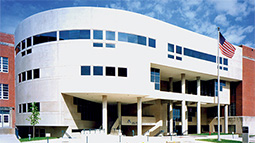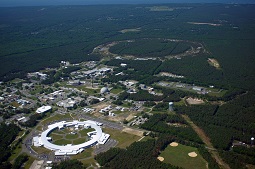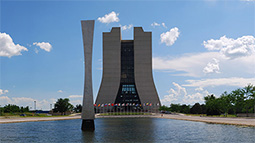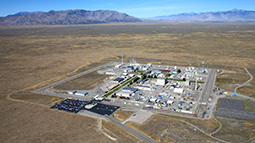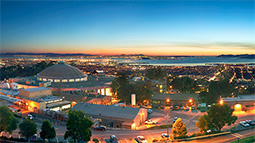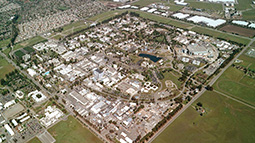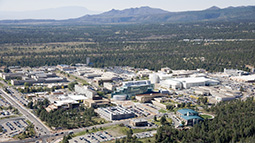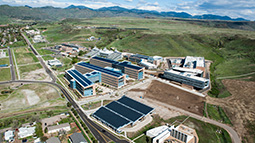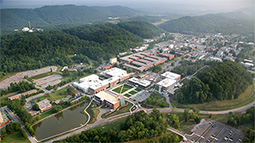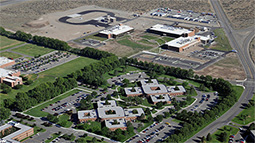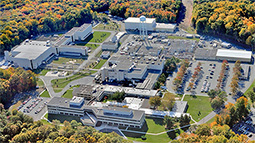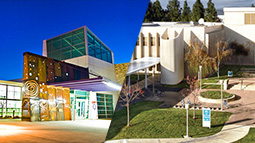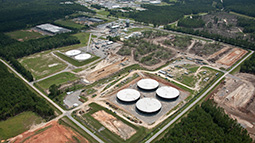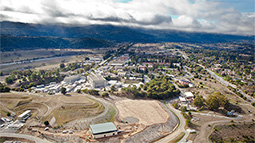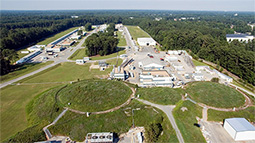National Labs, Profiles, and Contacts

The DOE National Labs address large scale, complex research and development challenges with a multidisciplinary approach that places an emphasis on translating basic science to innovation.
To learn more about these world-class facilities or to explore collaborative SBIR/STTR opportunities, visit https://labpartnering.org/labs which is sortable by facility and searchable by key word.
Facility SBIR points of contact are also listed below.
Ames National Laboratory [more]
Core Competencies
- Applied Materials Science and Engineering
- Chemical and Molecular Science
- Condensed Matter Physics and Materials Science
SBIR Contact
- Julienne Krennrich (515) 294-1202, jmkrenn@ameslab.gov
Argonne National Laboratory [more]
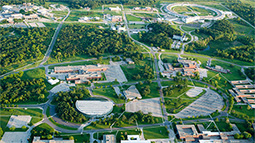
Argonne, Illinois
Argonne National Laboratory
Partner with ANL - https://www.anl.gov/partners
Apply to use ANL facilities - https://www.anl.gov/become-a-user
Collaborate with ANL - https://www.anl.gov/collaborative-research
Core Competencies
- Accelerator and detector science and technology
- Advanced computer science, visualization, and data
- Applied materials science and engineering
- Applied mathematics
- Biological and bioprocess engineering
- Biological systems science
- Chemical and molecular science
- Chemical engineering
- Computational science
- Condensed matter physics and materials science
- Cyber and information sciences
- Decision science and analysis
- Earth, environmental, and atmospheric science
- Isotope science and engineering
- Large-scale user facilities and advanced instrumentation
- Mechanical design and engineering
- Microelectronics
- Nuclear and radio chemistry
- Nuclear engineering
- Nuclear physics
- Particle physics
- Power systems and electrical engineering
- Systems engineering and integration
Major User Facilities
- Advanced Photon Source (APS)
- Argonne Tandem Linear Accelerator System (ATLAS)
- Argonne Leadership Computing Facility (ALCF)
- Center for Nanoscale Materials (CNM)
- Atmospheric Radiation Measurement (ARM) – The Southern Great Plains
- Intermediate Voltage Electron Microscopy-Tandem Facility (IVEM)
SBIR Contact
- Stephanie L. Teran, steran@anl.gov; 630.252.7650
Brookhaven National Laboratory [more]
Core Competencies
- Accelerator and Detector Science & Technology
- Advanced Computer Science, Visualization & Data
- Applied Materials Science and Engineering
- Applied Mathematics
- Biological Systems Science
- Chemical and Molecular Science
- Chemical Engineering
- Earth, Environmental, and & Atmospheric Science
- Computational Science
- Condensed Matter Physics and Materials Science
- Isotope Science and Engineering
- Large Scale User Facilities/Advanced Instrumentation
- Mechanical Design and Engineering
- Microelectronics
- Nuclear Engineering
- Nuclear Physics
- Nuclear & Radio Chemistry
- Particle Physics
- Power Systems and Electrical Engineering
- Systems Engineering and Integration
Major User facilities
- Relativistic Heavy Ion Collider (RHIC)
- National Synchrotron Light Source II (NSLS-II)
- Center for Functional Nanomaterials (CFN)
- NASA Space Radiation Laboratory (NSRL)
- Laboratory for BioMolecular Structure (LBMS)
- Tandem Van de Graaff (TVDG)
- Accelerator Test Facility (ATF)
- Quantum Network Facility
SBIR Contacts
- Vanessa Miller, (631) 344-5981, vmiller@bnl.gov
Fermi National Accelerator Laboratory [more]
Core Competencies
- Operation of the world’s highest-energy physics user facility
- Accelerator research, design, construction, and operation
- Superconducting magnet research, design, and development
- Superconducting Radio Frequency Accelerating Cavity research, design, and development
- Particle detector design and operation
- High-performance computing and networking
- International scientific collaboration
- Construction and management of scientific and technical projects
- Scientific training and education, all levels
Major User Facility
Fermilab Accelerator Complex, which produces the world’s most powerful, high-energy neutrino beam and provides proton beams for various experiments and R&D programs.
SBIR Contact
Idaho National Laboratory [more]
Core Competencies
- Nuclear Science User Facilities
- Biomass Feedstock National Scientific User Facility
- Wireless National User Facility
USER FACILITIES
- Analytical Laboratory
- Fuels and Applied Science Building
- Irradiated Materials Characterization Lab
- Space & Security Power Systems Facility
- Hot Fuel Examination Facility
- Fuel Conditioning Facility
- Transient Reactor Test Facility
- Experimental Fuels Facility
- Additional MFC capabilities
SBIR Contact
- small.business@inl.gov, 208-526-8564
Lawrence Berkeley National Laboratory [more]
Core Competencies
- Discovery Science
- AI, Math, and Data
- Accelerator Technologies
- Cosmic Frontiers
- Frontier Computing Sciences
- Materials and Chemical Sciences
- Microelectronics and Beyond
- Mysteries of Matter
- Quantum Science
- Clean Energy
- Alternative Energy
- Bioenergy and Biofuels
- Biomanufacturing
- Carbon Management
- Energy Efficiency
- Energy Storage
- Energy Systems
- Hydrogen
- Manufacturing Decarbonization
- Sustainable Transportation
- Healthy Earth Systems
- Clean and Affordable Water
- Climate
- Earth and Ecological Systems
- Human Health
- Microbes to Ecosystems
- Future Science
- Emerging Ideas
- Scientists of Tomorrow
- Emerging Capabilities
DOE National User Facilities
- Advanced Light Source (ALS)
https://als.lbl.gov/users/prospective-users/ - Molecular Foundry
- Joint Genome Institute (JGI)
https://jgi.doe.gov/user-programs/ - National Energy Research Computing Center (NERSC)
- Energy Sciences Network (ESnet)
- Other Facilities and Centers
SBIR Contact
- Gail Chen, gailchen@lbl.gov
Lawrence Livermore National Laboratory [more]
Core competencies:
- Advanced Materials and Manufacturing
- BioScience and Bioengineering
- Earth and Atmospheric Science
- High Energy Density Science
- High Performance Computing, Simulation, and Data Science
- Laser and Optical Science and Technology
- Nuclear and Isotopic Science and Technology
Major User Facilities:
- National Ignition Facility — The largest, most-energetic laser facility in the world.
- Livermore Computing Center — One of the largest high performance computing centers in the world and home to many of the world’s fastest and most powerful supercomputers, including the future National Nuclear Security Administration exascale machine El Capitan.
- National Atmospheric Release Advisory Center (NARAC) — National resource for predicting the spread of airborne releases of hazardous materials.
- Forensic Science Center — Nationally recognized forensic analysis capabilities in support of nuclear, chemical, explosives and biological counterterrorism.
- High Explosive Applications Facility (HEAF) — State-of-the-art research facility for formulating, characterizing, processing and testing energetic materials.
- Site 300 — Remote site for high explosives and environmental testing.
- Center for Accelerator Mass Spectrometry (CAMS) — World’s most versatile and productive accelerator and mass spectrometry facility.
- Livermore Valley Open Campus (LVOC) — An open, unclassified research and development space to connect industry and academia with laboratory expertise to advance high performance computing, energy and environmental security, cyber security, economic security and non-proliferation.
- Center for Micro and Nano-Technology (CMNT) — A multiuser facility offering tools for device fabrication and characterization to support research areas including microelectromechanical systems, electronics, photonics, lasers, quantum computing and bio-implantable devices.
- Advanced Manufacturing Laboratory — Open facility aimed at fostering partnerships between LLNL and the external community though cutting-edge 3D-printing systems, advanced materials research and some of the world’s most sophisticated manufacturing and nanomanufacturing equipment.
SBIR Contact
- Chung Bothwell, bothwell1@llnl.gov
Los Alamos National Laboratory [more]
Core Competencies
- Accelerators, Electrodynamics
- Bioscience, Biosecurity, Health
- Chemical Science
- Earth & Space Sciences
- Engineering
- Information Science, Computing , Applied Math
- Materials Science
- National Security, Weapons Science
- Sensors & Instrumentation
- Nuclear & Particle Physics, Astrophysics, Cosmology
Major User Facilities
- Center for Integrated Nanotechnologies (CINT): a facility for discovering the scientific principles that govern the design, performance, and integration of nanoscale materials; with Sandia National Laboratories.
- Los Alamos Neutron Science Center (LANSCE): has a vibrant research program in fundamental science, providing the scientific community with intense sources of neutrons and protons to perform experiments supporting civilian research and the production of medical and research isotopes.
- National High Magnetic Field Laboratory: a general user facility open to all researchers who wish to perform experiments in high magnetic fields.
SBIR Contacts
- Ian Foti-Landis, (505) 412-2512, sbir-sttr@lanl.gov
- MaryAnn Morgan, (505) 667-5324, sbir-sttr@lanl.gov
National Renewable Energy Laboratory [more]
Core Competencies
- Renewable electricity production and use
- Renewable fuels formulation and use
- Integrated energy system engineering and testing
- Strategic energy analysis
SBIR Contact
- Anne Miller; anne.miller@nrel.gov
Oak Ridge National Laboratory [more]
Core Competencies
- Accelerator Science
- Advanced Computer Science, Visualization, and Data
- Applied Materials Science and Engineering
- Applied Nuclear Science and Technology
- Biological Systems Science
- Chemical and Molecular Science
- Chemical Engineering
- Climate Change Science
- Computational Science
- Condensed Matter Physics and Materials Science
- Environmental Subsurface Science
- Large Scale User Facilities/Advanced Instrumentation
- Nuclear Physics
- Particle Physics
- Plasma and Fusion Energy Science
- Systems Engineering and Integration
Major User Facilities
- Building Technologies Research & Integration Center (BTRIC)
- Center for Nanophase Materials Sciences (CNMS)
- Center for Structural Molecular Biology (CSMB)
- Carbon Fiber Technology Facility (CFTF)
- High Flux Isotope Reactor (HFIR)
- Manufacturing Demonstration Facility (MDF)
- National Transportation Research Center (NTRC)
- Oak Ridge Leadership Computing Facility (OLCF)
- Spallation Neutron Source (SNS)
SBIR Contact
- partnerships@ornl.gov
- (865) 576-7658
Pacific Northwest National Laboratory [more]
Core Competencies
- Microbial and cellular biology
- Environmental sciences
- Analytical and interfacial chemical sciences
- Radiological sciences
- Information analytics
- Sensing and measurement technologies
Major User Facilities
- William R. Wiley Environmental Molecular Sciences Laboratory, a U.S. Department of Energy (DOE) national user facility, currently shared and used by researchers from around the world. Research at EMSL focuses principally on developing a molecular-level understanding of the physical, chemical, and biological processes that underlie the most critical environmental issues facing DOE. Located on PNNL’s campus.
- Applied Process Engineering Laboratory is an eastern Washington technology business startup user facility, supported in part by PNNL. APEL provides engineering- and manufacturing-scale space and chemical, biological, and electronic laboratories and equipment for developing, validating, and commercializing new products. Entrepreneurs, engineers, scientists, and university staff can access this facility. PNNL scientists, engineers, and other professional staff are available to APEL occupants for consulting, collaboration, or professional support.
- Bioproducts, Sciences, and Engineering Laboratory is a joint effort between Washington State University (WSU) and PNNL. Located on the WSU Tri-Cities campus in Richland, Washington, researchers use the laboratory to develop technology for converting low-value agricultural byproducts and residues into value-added chemicals for products like plastics, solvents, fibers, pharmaceuticals, fuels, and fuel additives.
SBIR Contact
Princeton Plasma Physics Laboratory [more]
Core Competencies
- Experimental analysis of stability and confinement of fusion plasmas
- Plasma theory and computational physics for fusion and other applications
- Physics and engineering design and operation of experimental plasma fusion facilities
- Computer engineering, including data acquisition, instrumentation, and control systems
- Physics and technology of plasma applications to advance industrial technologies
- Environmental, safety, and health aspects of the operation and removal of experimental fusion devices
Major User Facilities
- National Spherical Torus Experiment (NSTX), to advance knowledge for the spherical torus plasma confinement concept
- National Compact Stellarator Experiment (NCSX), a device to study a compact stellarator confinement concept, for which a preliminary design is under way. Construction began in 2004.
- Current Drive Experiment-Upgrade (CDX-U), to investigate plasma interactions with liquid lithium for fusion reactor technology.
- Magnetic Reconnection Experiment (MRX), to study the breaking and reconnection of magnetic field lines in plasmas
SBIR Contact
- Chris Wright, cwright@pppl.gov, 609-243-2425
Sandia National Laboratories [more]
Core Competencies
- Bioscience
- Computing and information science
- Engineering science
- Geoscience
- Materials science
- Nanodevices and microsystems
- Radiation effects and high energy density science
Major User Facility
The 25 user facilities and technology deployment centers at Sandia include:- Combustion Research Facility, which conducts a broad range of basic and applied research and development in combustion science and technology, aimed at improving the nation’s ability to use and control combustion processes
- Explosives Components Facility, a state-of-the-art facility that provides a full range of chemical, material, and performance analysis capabilities for energetic materials and explosive components
- Intelligent Systems and Robotics Center, which contains the Robotic Manufacturing Science and Engineering Laboratory, a 73,000-square-foot facility built to bring together all of Sandia’s robotics researchers in an environment conducive to technology transfer Primary Standards Facility, assures the accuracy of measurements for customers by certifying standards, developing measurement techniques, and advancing the state of the art in metrology, the science that deals with measurement
- Shock Technology and Applied Research Facility, a state-of-the-art facility that can provide a full range of projectile/target interactions
SBIR Contact
- Laura Lovato, (505) 844-9260, llovato@sandia.gov, supplier@sandia.gov
Savannah River National Laboratory [more]
Core Competencies
- Accelerating remediation, minimizing waste, & reducing risks
- Creating manufacturing & energy solutions for EM, NNSA, and other sponsors
- Enabling next-generation nuclear materials processing & disposition
- Assuring production & supply of strategic materials & components
- Sensing, characterizing, & assessing materials production & environmental impacts
- Securing connected control systems & associated data
SBIR Contact
- Daren Timmons, 803.989.5854, daren.timmons@srnl.doe.gov
SLAC National Accelerator Laboratory [more]
Core competencies:
- Accelerators
- Detectors
- High-throughput data acquisition
- Big Data computation and visualization
- X-rays
- Lasers
- X-ray free-electron lasers
- Materials science
- Chemical science
- Bioscience
- Matter in extreme conditions
- Batteries
- Solar energy
- Catalysis
- Smart grid
- Dark matter
- Dark energy
- Cosmic inflation
- Particle physics
Major user facilities:
- Linac Coherent Light Source (LCLS), the world’s first hard X-ray free-electron laser. It provides ultrashort, high-energy pulses, a billion times brighter than those previously available at synchrotrons, at a rate of up to 120 per second.
- Stanford Synchrotron Radiation Lightsource (SSRL) produces bright X-ray light for probing matter at the atomic and molecular level.
SBIR Contact
- Matt Garrett sbir@slac.stanford.edu
Thomas Jefferson National Accelerator Facility [more]
Core Competencies
- Experimental nuclear physics
- Nuclear theory
- High-energy physics
- Advanced accelerator research
- Synchrotron radiation research
- Astroparticle physics
- Technology and education
- Energy Recoverable Linacs
- Cryogenics
- Superconducting RF Technology
- Radiation Detector and Imaging Technology
Major User Facilities
- Continuous Electron Beam Accelerator Facility, a continuous-wave, recently upgraded to deliver 12 billion electron volt (12 GeV) beam once commissioning is complete. The CEBAF Accelerator is capable of delivering polarized electron beams to three separate end stations simultaneously.
- Free-Electron Laser (FEL), a superconducting radio-frequency-(srf)-based laser that has delivered 14.2 kilowatt (kW) of infrared light and provided proof of principle for srf energy recovered linacs.
SBIR Contacts
- Mariana Goldin, partnerships@jlab.org
National Lab Strategic Partnership Project SBIR/STTR Agreement Template
Are you looking to engage with one of DOE’s national laboratories during your SBIR or STTR project? Several of the DOE labs, including the Ames Laboratory, Argonne National Laboratory (ANL), Brookhaven National Laboratory (BNL), Fermi National Accelerator Laboratory, Idaho National Laboratory (INL), Los Alamos National Laboratory (LANL), National Renewable Energy Laboratory (NREL), Oak Ridge National Laboratory (ORNL), Pacific Northwest National Laboratory (PNNL), Princeton Plasma Physics Laboratory (PPPL) and Sandia National Laboratory (SNL) have streamlined this engagement process for SBIR and STTR firms. Here you’ll find the U. S. Department of Energy’s approved, non-negotiable Strategic Partnership Project (SPP) SBIR/STTR Agreement template to be used for these Laboratories.
Looking for Partners?
Join the SBIR Partner Platform as an INNOVATOR. This public, self-supporting platform1 facilitates partnering between DOE small business applicants and awardees (INNOVATORS) and various industry stakeholders (i.e., investors, service providers, utilities, etc.) in their representative ecosystems (PARTNERS). Network with other INNOVATORS to find subject matter experts (SME) and subcontractors and/or collaborators to complete your team! Review the platform overview webinars to learn more about the objectives of this partnering program as well as the features and functions of the database by ecosystem role: Partners or Innovators.
Questions - contact Eileen Chant, Tech to Market Advisor - Partnering
1 By enabling and publishing the DOE SBIR Partnering Platform, DOE is not endorsing, sponsoring, or otherwise evaluating the qualifications of the individuals and organizations that appear on this platform as partners, resources, awardees or innovators.


